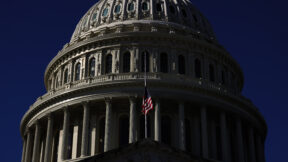CNBC Host Gushes About GDP Numbers: ‘We Are Cooking in Grease!’
CNBC anchor Rick Santelli had a big, enthusiastic reaction to fourth-quarter GDP growth, telling viewers, “We’re cooking in grease!”
On Friday morning’s edition of CNBC’s Squawk Box, Santelli ticked through a litany of economic numbers as they were released. But when he got to the stellar Q4 GDP figure that closed out President Joe Biden’s first year in office, Santelli perked up.
“Initial jobless claims for the week of January 22, well, they moved down 26,000 from 286,000,” Santelli, while noting that continuing claims were “a bit higher than expected,” and ticking through some other indicators that were pretty much steady.
“And finally, GDP, first look at fourth quarter is 6.9 percent!” Santelli enthused. “Much, much better than the five-and-a-half [estimate], and it hearkens back to pre-thoughts, before Omicron hit at the end of the year. Obviously, they overstated the effects in the economy.”
Santelli continued, “That is a good number, and if you look at the annualized Q over Q at 6.9 versus last [year], look, at 2.3. Boy, we are cooking in grease! Probably the best annual year-over-year GDP since 1984.”
But it wasn’t all rosy, as Santelli noted, the GDP price index was higher than expected, a continuation of the price increases that have become a singular focus with the media and with voters, despite other positive economic news.
The Bureau of Economic Analysis released its 4th quarter GDP estimate Thursday morning, which included estimates for the entire year:
Real GDP increased 5.7 percent in 2021 (from the 2020 annual level to the 2021 annual level), in contrast to a decrease of 3.4 percent in 2020 (table 1). The increase in real GDP in 2021 reflected increases in all major subcomponents, led by PCE, nonresidential
fixed investment, exports, residential fixed investment, and private inventory investment. Imports increased (table 2).
…Current-dollar GDP increased 10.0 percent, or $2.10 trillion, in 2021 to a level of $22.99 trillion, in contrast to a decrease of 2.2 percent, or $478.9 billion, in 2020 (tables 1 and 3).
Watch above via CNBC.




